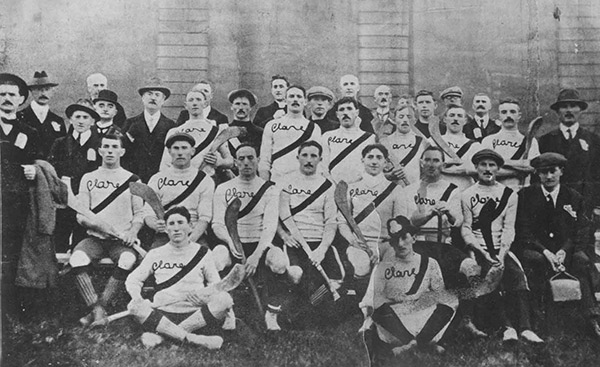GAA honours First World War veterans
Published in Issue 1 (January/February 2019), News, Revolutionary Period 1912-23, Volume 27In recent years the commemoration of those who participated in the First World War has become less contentious.
By William Murphy
In an initiative that attracted considerable attention, each day for eleven days, concluding on 11 November 2018, the Gaelic Athletic Association both tweeted and published on its website a short profile of a player or administrator who had fought in the First World War.
The sequence began with Charlie Duggan from Tralee, who played for Kerry during the All-Ireland football championship of 1903, a campaign that ended with Kerry’s first All-Ireland football title. Duggan, already a veteran of the Boer War, later fought at the Battle of Mons. It ended with Jimmy Clyne from Ballinamore, who played for Leitrim and died at Vermelles in October 1915. In between, James Rossiter (Wexford), John Cunningham (Tipperary), John Fox (Clare), Barney Hennessy (Carlow), Thomas Bradley (Monaghan), Laurence Roche (Limerick), Frank Butler (Tipperary), Willliam Manning (Antrim) and Thomas Mulligan (Antrim) represented a range of GAA careers and war experiences. Their individual stories were fascinating and, in the absence of a comprehensive list, together they captured something of the overlap between active membership of the GAA and those with a war record. John Fox, for example, won an All-Ireland hurling medal with Clare in 1914 and fought at the Battle of the Somme with the Royal Munster Fusiliers. Laurence Roche of Bruree served with and recruited for the same regiment after a GAA career that saw him win an All-Ireland football medal and All-Ireland athletics titles and become chairman of the Limerick county board.
In recent years the commemoration in Ireland of those Irishmen who participated in the First World War has become less contentious. Nonetheless, the attention that the GAA’s initiative garnered from print and broadcast media, North and South, indicates that—in some quarters at least—the GAA continues to be identified with a particular brand of nationalism. The media response was characterised by considerable approbation (some of it of the patronising variety), but also by mild surprise and a peppery seasoning of ‘and it’s about time too’.
It is not entirely surprising that this should have been the response. Over several decades, the GAA was thoroughly implicated in creating a monochrome version of its own past. In pointing to this, several of the media responses highlighted, in particular, the GAA’s determined ‘rebranding’ during the 1930s of Croke Park’s most famous terrace from ‘Hill 60’, named after a Gallipoli battle site, to ‘Hill 16’, in honour of the Rising, thus erasing one story while elevating another.

Above: One of the First World War veterans featured: John Fox (second player from the left in the third row), a member of the Clare (Quin) team that won the 1914 All-Ireland hurling title, fought at the Battle of the Somme with the Royal Munster Fusiliers. (GAA Museum)
In recent decades, however, the GAA has shifted away from a rather rigid, even censorious, approach to creating an ‘official’ story. Instead, it has facilitated scholars investigating and publishing on its history in all its shades. The opening of the GAA Museum and Archive at Croke Park in 1998 marked an important stage in that process. If, when it opened, the panels in the museum still emphasised the links of the GAA to the revolutionary movement, it was the systematic collecting, preserving and making available of the association’s material culture and its written records at that archive that more than any other development opened up plural approaches to the GAA’s history.
This has been reflected in the GAA’s approach to the Decade of Centenaries. When it invited Professor Gearóid Ó Tuathaigh to edit The GAA and Revolution in Ireland 1913–1923 (Collins Press, 2015), it included essays that explored the GAA’s relationship to varieties of nationalism and nationalist activism but also to unionism, as well as an essay on the effects of the First World War on the association by Ross O’Carroll. Under the direction of its then archivist, Mark Reynolds, the GAA created a website that hosts an impressive range of digitised administrative records from the revolutionary era. These are freely available to all. In addition, the GAA has established a History and Commemoration Committee, currently chaired by Damian White, to advise it on its approach to the Decade of Centenaries. The initiative to publish the profiles of the First World War veterans originated with that committee.
Indeed, Donal McAnallen, who is a member, has been raising awareness of the connection between GAA members and the First World War for several years. In 2014, coinciding with the centenary of the outbreak of the war, he launched a project, ‘Forgotten Gaelic Volunteers’, under the auspices of the Ulster Council of the GAA and sponsored by the Heritage Lottery Fund. That project aimed to identify as many as possible of the GAA members in Ulster who died in the war. This remains an ongoing investigation for McAnallen, and in many ways the recent initiative grew out of his work.
Commemoration is, of course, a treacherous activity. It frequently reveals more about contemporary concerns than about the past, looking (as it often does) towards the consensus of the day. It is, then, not that noteworthy that a commemorative initiative such as the GAA’s should draw widespread approval, and far more interesting that it had the capacity to surprise.
William Murphy (DCU) is co-author (with Anne Dolan) of Michael Collins: the man and the Revolution (Collins Press, 2018).
















